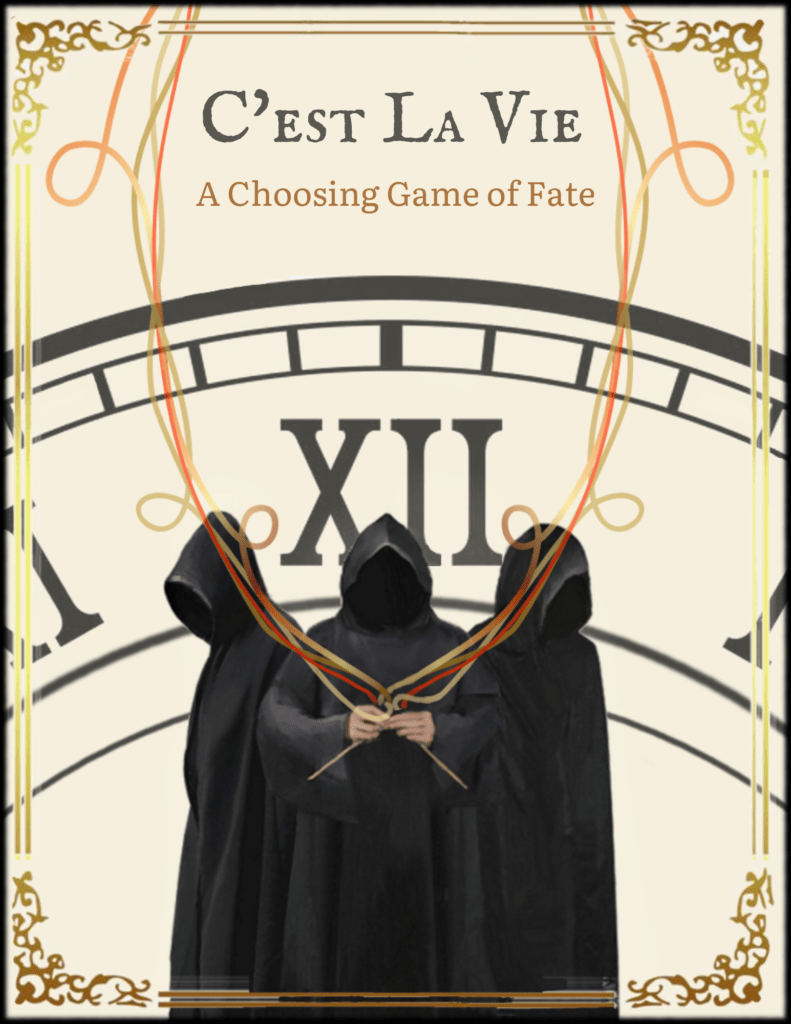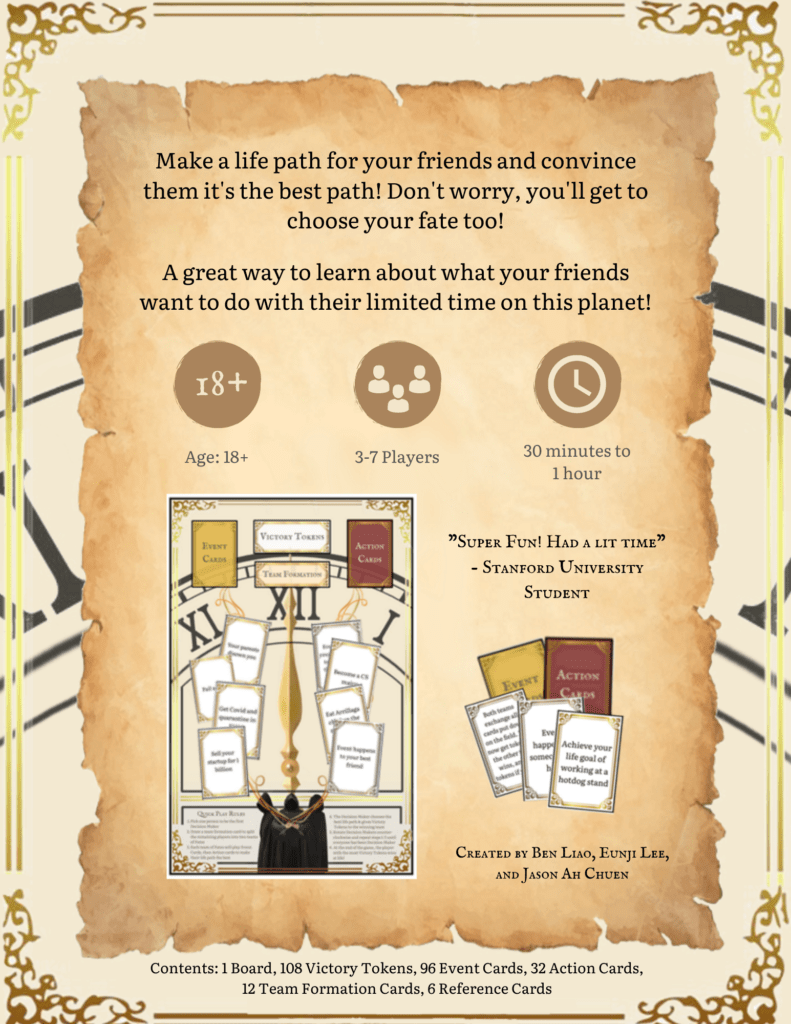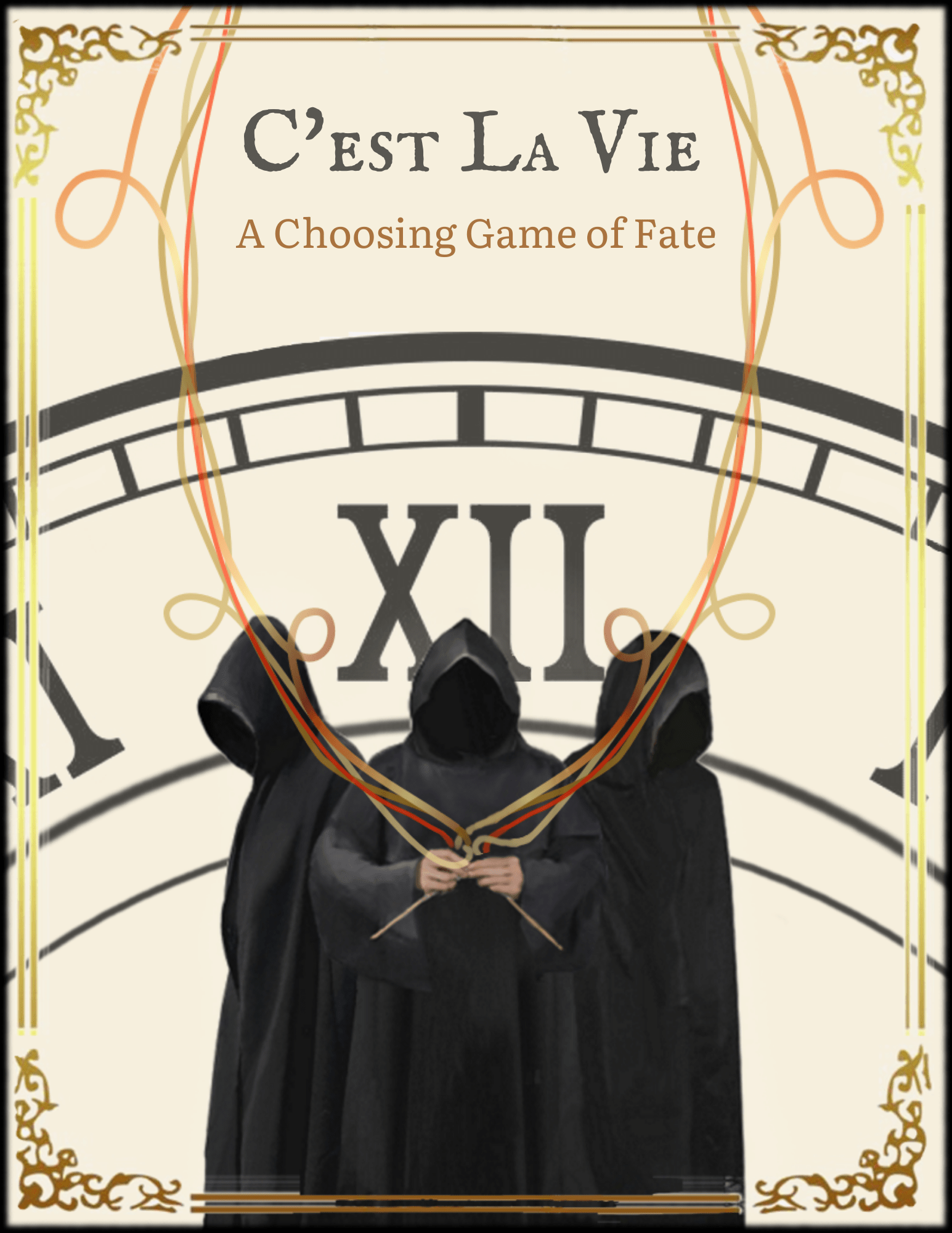Creators: Benjamin Liao, Eunji Lee, Jason Ah Chuen
Creator’s Statement
We set out to create a situation where strangers could become friends, and friends can become even closer friends, by engaging in good-natured discussions and sharing their sense of humor within the “magic circle” of a game. One of our favorite social games (and one of our inspirations for C’est La Vie) was Cards Against Humanity; players put together combinations of cards that showcase their own humor while also trying to get the chooser to pick theirs.
However, we wanted the game to be more collaborative, so that players can get to talk to each other and discuss why their combinations are the best. We wanted to capture that gotcha! moment more commonly found in strategy-based games, where you make a comeback by messing with another player’s hand. Most of all, it was important to us that players could relate to (and laugh with) the prompts they were given and the scenarios they were thinking of, all while engaging in a fantasy composed of (possibly) familiar events. After all, what’s more relatable than real life?
That’s how C’est La Vie was born: a choosing game made for college students where players can construct, defend, and decide on their own paths in life.
Concept Map and Ideation
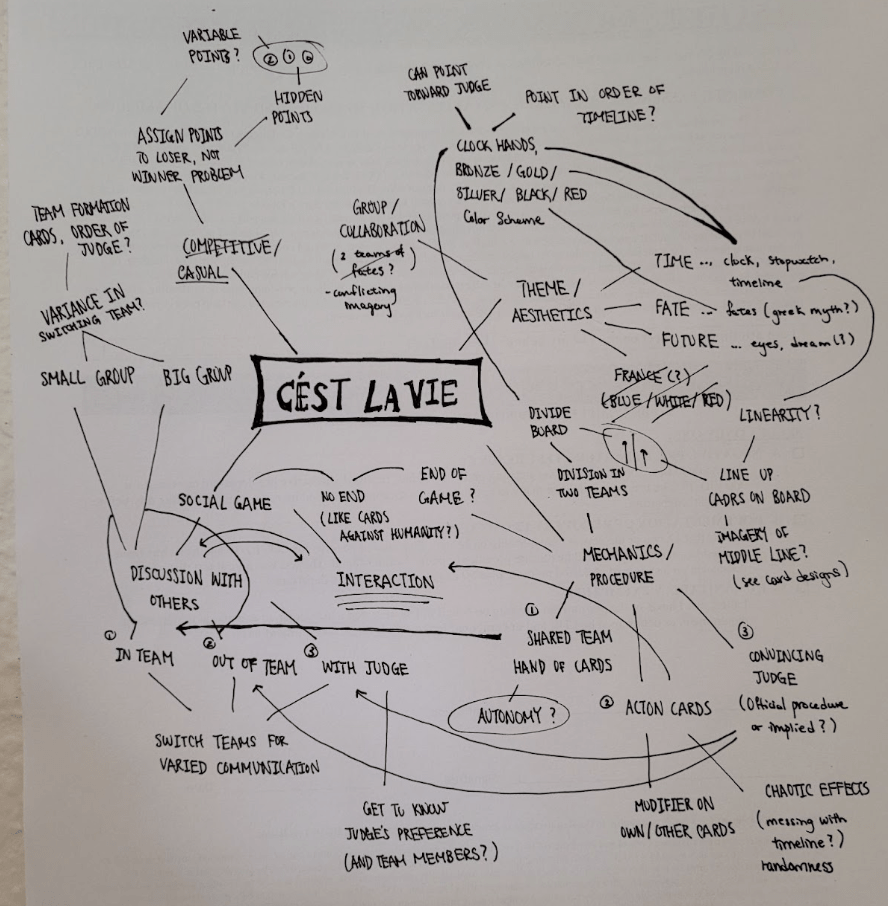

Formal Elements and Values: Initial Decisions
Brainstorming and Values
Our initial brainstorming tagline for C’est La Vie was Cards Against Humanity + Game of Life. We knew off the bat that we wanted to have some sort of prompt + response card combinations and points as resources, similar to Cards Against Humanity. There would also be a single rotating “chooser” that determines which card combination is the best and a series of card combinations to choose from. The objective of the game would be to accumulate the most points possible in the allotted number of turns (meaning the Decision Maker chose your card combinations the most number of times).
Above all else, we wanted to center the value of friendship / fellowship in our game. While there is a competitive aspect to the game as well as components of narrative and fantasy, we didn’t want the game to get bogged down by trying to win more points or pick the card combinations that “make the most sense”. The most important part of the game is that people are laughing, talking, getting to know each other, and strengthening their friendships; therefore, we tried to make it easy to win points and entertaining when the other team messes with your cards (instead of frustrating or anger-inducing).
Resources
In order to effectively incorporate the “life” aspect of the theme, we had to add in more chances where fate could intervene – also known as randomness. We added both Event and Action cards as resources. Event Cards are similar to the white cards in Cards Against Humanity; they are short scenarios that could happen in one’s life, and players arrange combinations of them to build a life path. Action Cards allow players to modify the Event Cards placed on the board; either the meaning of an event is altered, or the placement of cards is switched or removed.
A game board is utilized to guide the players on where to place their cards and where to draw cards from, and physical tokens help players remember how many points they’ve earned.
Player Interactions
From here, we had to decide how the players would interact with each other. Would it be a multilateral competition, where players compete to earn the most points (as in Cards Against Humanity)? Or should there be teams, and if so, how would the teams be able to accommodate a rotating chooser? We settled on a combination of multilateral and team competition. Within one round, the game is a team competition; all players other than the Decision Maker split into two teams, and the two teams work within themselves and against each other to pick the best combination of event and action cards and convince the Decision Maker to choose their path. Although the team wins together, the next round will switch up the teams; therefore, point totals are individual and the overall game (and outcome) is determined via multilateral competition. The decision to have two teams was made largely because it takes a lot of time to debate and place Action Cards – having only two sets of cards would cut down on play time.
Rules and Procedures
Initially, our rules were very simple. As long as each team drew the correct number of cards at the designated points in the game, both teams could put down as many event and action cards as they wanted on either side of the board to create the best path.
Conversely, our procedures were initially very complicated. For one Decision Maker, the teams would compete to win best two out of three points from the Decision Maker. They start out with 4 Event and 2 Action Cards, then between each point, draw 2 more Event Cards and 1 more Action Card. The winning team is the one that first reaches 2 points from that Decision Maker, and each member of that team would reach eyes-closed into a bag of tokens. The token would either be a dummy token (not worth anything) or a victory token (worth 1 point towards your final score). Playtesting soon revealed that our rules were too simple, while our procedures were too complicated. Sometimes, teams would place all their cards on one side, or not put any cards down at all. Additionally, players were very, very, very confused about victory vs dummy tokens, and the best-two-out-of-three competition slowed down gameplay a lot while also adding to the confusion for new players.
Therefore, we had to iterate and make some changes! The next section describes what approaches we took from our initial formal elements.
Testing and Iterations
Iteration #1
Below is a picture of what our original rules and procedures looked like. We brought this to class for playtesting and we observed that our playtesters, a group of 5 students from class, were either confused or annoyed by how long the rules and procedures were. A couple of them took pictures of the sheet of paper to read it and it took a while (about 5 minutes) before they even started setting up the game.
During the game, people were confused about how many cards they can play each round. They were also confused about when they could play action cards vs event cards. Each round was supposed to be a “best out of 3 points” but that rule was overlooked by the players. Those happened probably because there were lots of rules and procedures to memorize, some of the procedures were too complex, and none of the important rules (e.g. number of cards, number of points, etc) were emphasized. Furthermore, as mentioned in the previous section, the debate sometimes felt unbalanced as sometimes there were way more cards placed on one team’s side.
All of those observations meant that we had to rework a lot on the rules and procedures.
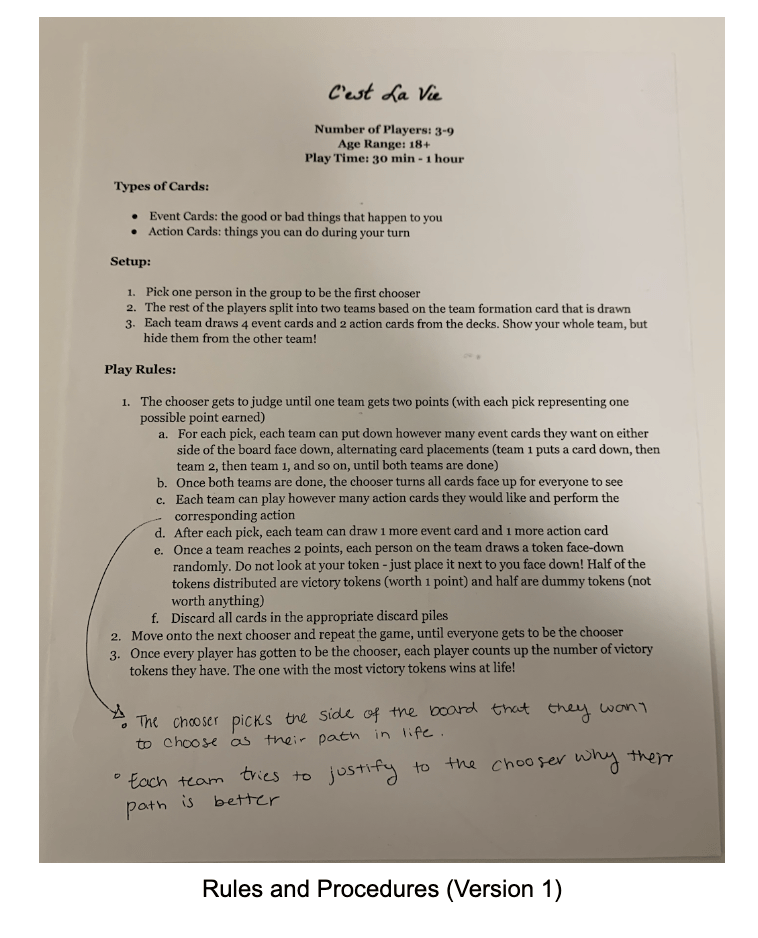
People were also confused about the difference between action and event cards. It also happened that a team would accidentally play an event card because of an action card. This meant that we had to better emphasize the difference between them, and perhaps color code them to make them more distinguishable.
The order in which the action cards are played makes a difference in the outcome, hence we also needed to figure out a rule for that in future playtesting.
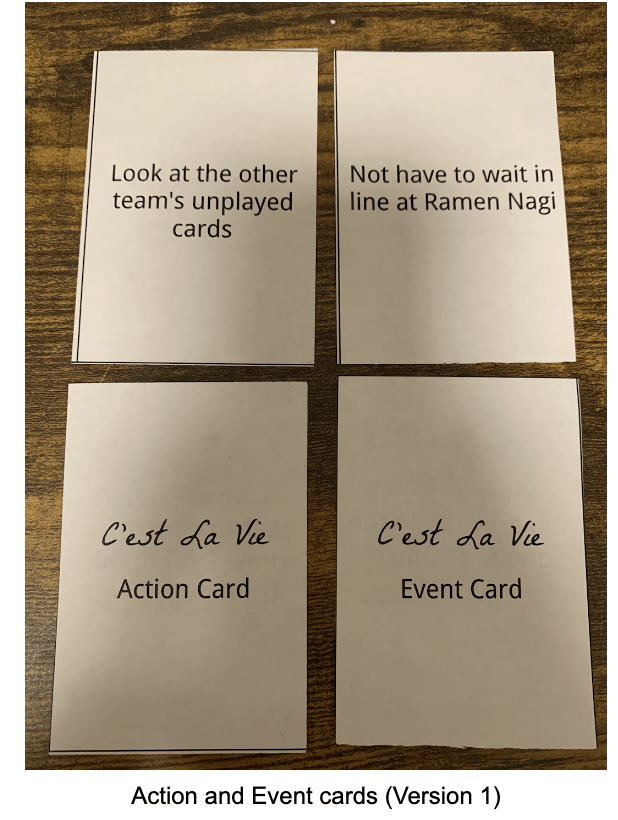
As mentioned in the previous section, people were also extremely confused about the idea of dummy and victory tokens. Our motivation for this was that the Decision Maker might be picking their favorite path based on who was winning, and we wanted to avoid that. However, we observed that Decision Makers were not competitive enough to take that into account. Instead, they were simply having fun with the game and picking solely based on the debates, which we confirmed by asking them at the end of the playtesting session. Hence, we decided to abandon this idea of dummy and victory tokens in future playtesting.
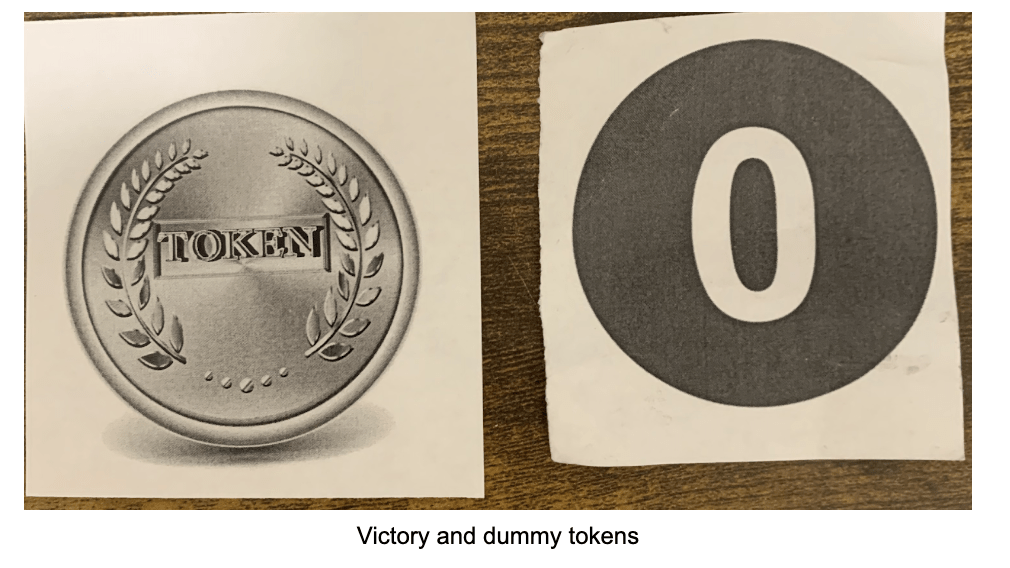
Finally, we saw that the chooser seemed a little bored while the teams were discussing which cards to play. Sometimes one team would also take more time than the other to play. This is more or less inevitable in this type of judging game. We thought of maybe introducing a timer in the future to reduce this problem.
On the other hand, there were lots of things that went well with the first playtesting session. The most important and encouraging observation was that playtesters were having lots of laughter and funny, loud discussions. Playtesters had lots of discussions within their own team to decide which cards to play, and then were very engaged in convincing the Decision Maker why their path was the better one. The Decision Maker was very engaged in and also participated in the discussions. Furthermore, when the action cards were played, they often resulted in an expected change in the events, which led to even funnier discussions.
People also thought that the board did the job well – it was very simple and intuitive to use! We decided to keep more or less this layout in future iterations of the board.
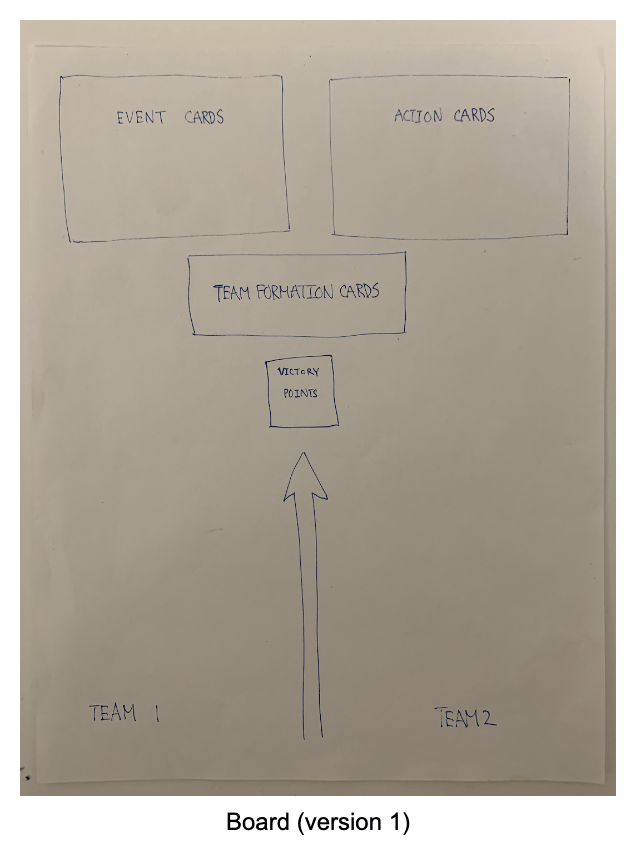
Another great observation was that playtesters tried to think about what the Decision Maker would prefer in their lives, which showed how this game can help players get to know each other better. The social aspect of our game was working!
There were a bunch of other useful things that we noticed or received feedback on:
- The action cards that were played were most often modifier cards, i.e. cards that could change the definition of an event. We decided to create more of such cards.
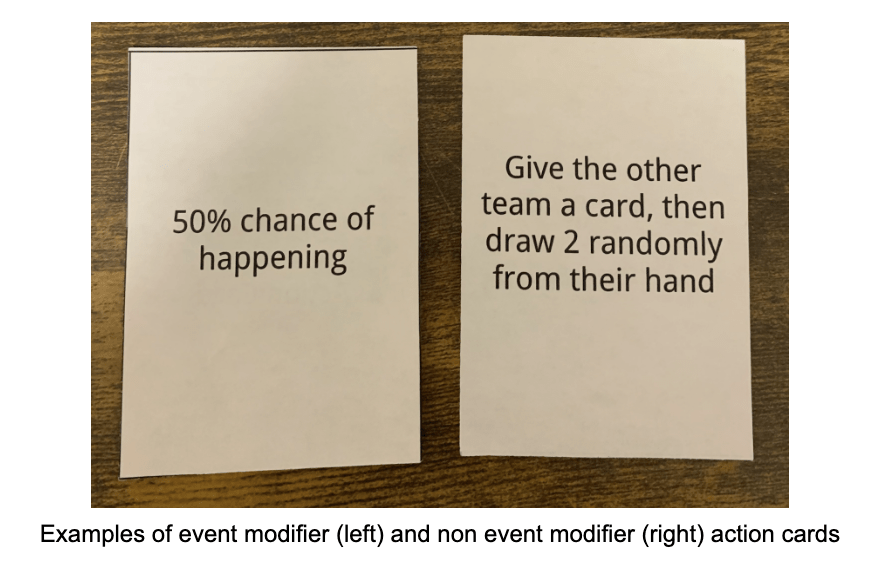
- We tried two types of team formation. The first option was giving people cards with either number 1 or 2 written on them, and those with the same number would be on the same team. The second option was having a team formation prompt. People seemed to like the second option better since they got to make teams based on “interesting facts about other players”.
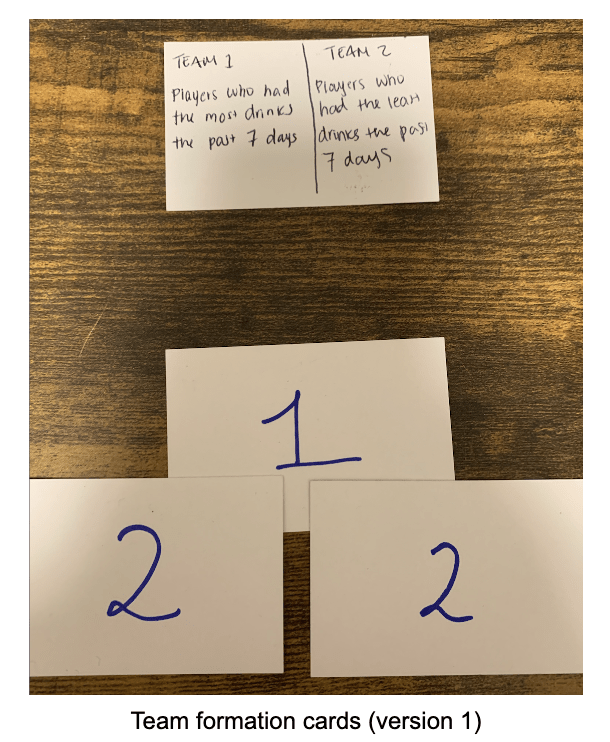
- Players liked being able to put cards on the other team’s side in order to mess with them.
Iteration #2
In this iteration, we did not change much about the game but we made sure that the game was played according to the procedures (e.g. best of 3 points for each round). We also introduced a new rule that each team must play at least one card on their own side to avoid the possibility of having unbalanced sets of cards.
We found out that the best of 3 points went relatively well, but each round took longer – perhaps a little too long. Furthermore, there was still the problem of playtesters actually understanding this rule, especially because of confusion between points and victory tokens, and between points and rounds. We decided to get rid of this procedure in future iterations.
The new rule of playing at least one card on your own team’s side worked really well as it resulted in the discussions being balanced between the two sides.
Other feedback that we received was generally the same as before. An additional insight was that people really liked how funny the prompts were, especially the really specific or relatable ones.
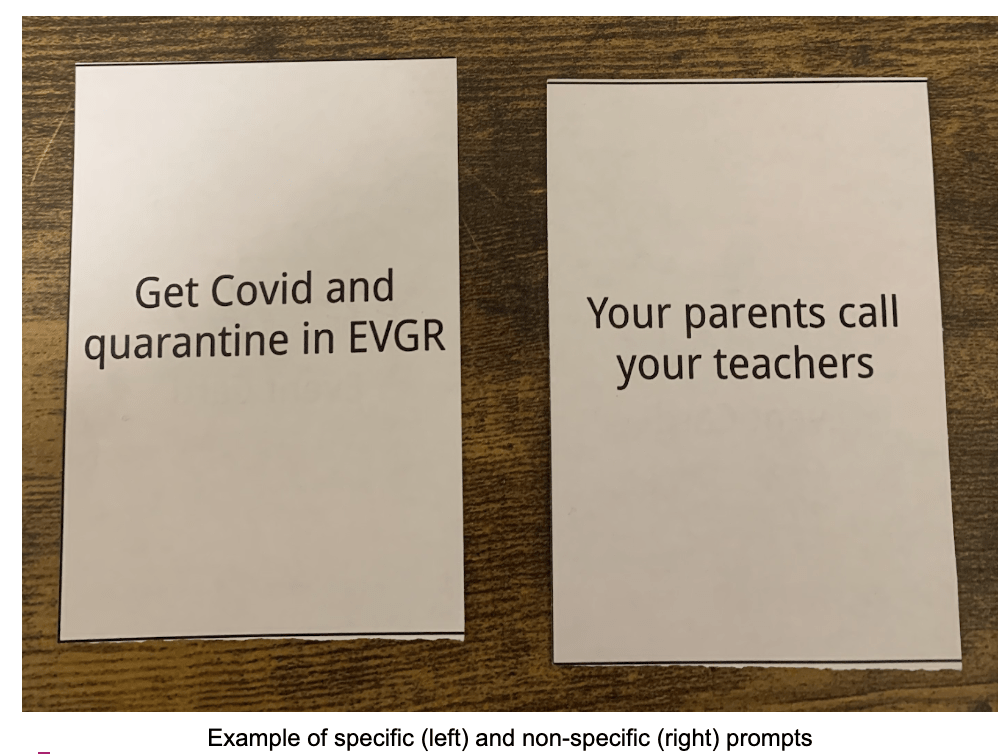
Iteration #3
In this iteration, we implemented most of the feedback from previous iterations.
We simplified the rules and procedures, which made the setup faster and also made playtesters less confused in general. However, there was still some friction in the game in the first round of the game as people had to get used to all the rules and procedures.
We removed the dummy tokens, which resulted in no confusion at the end of the game when it was time to see who the winner was.
We introduced a new rule about the order of action cards being played. We decided that the actions would be performed based on the order they were played on the board. This resulted in less conflicts and questions.
Team formation prompts were used, which received positive feedback.
During the game, the Decision Maker was on their phone once but later said they liked having a little bit of downtime to check their notifications.
Iteration #4
In this iteration, we had much simpler procedures which were written on the board and also had reference cards which contained the essential rules. The setup was very fast and no one seemed confused about the rules and procedures. We also had a slightly more comprehensive rule book, but no one used it – which showed that the board instructions and reference cards worked!
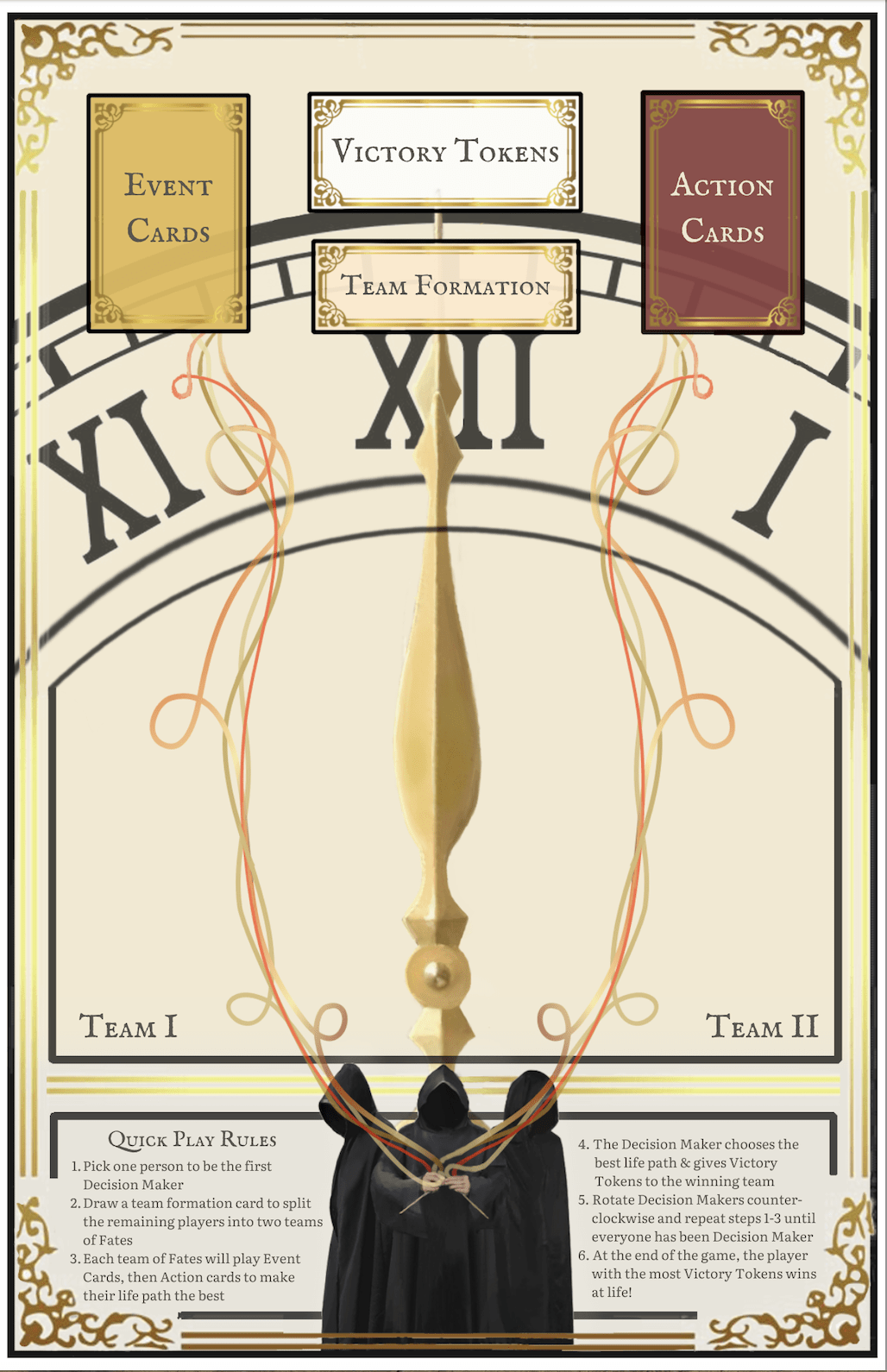
Board with instructions at the bottom
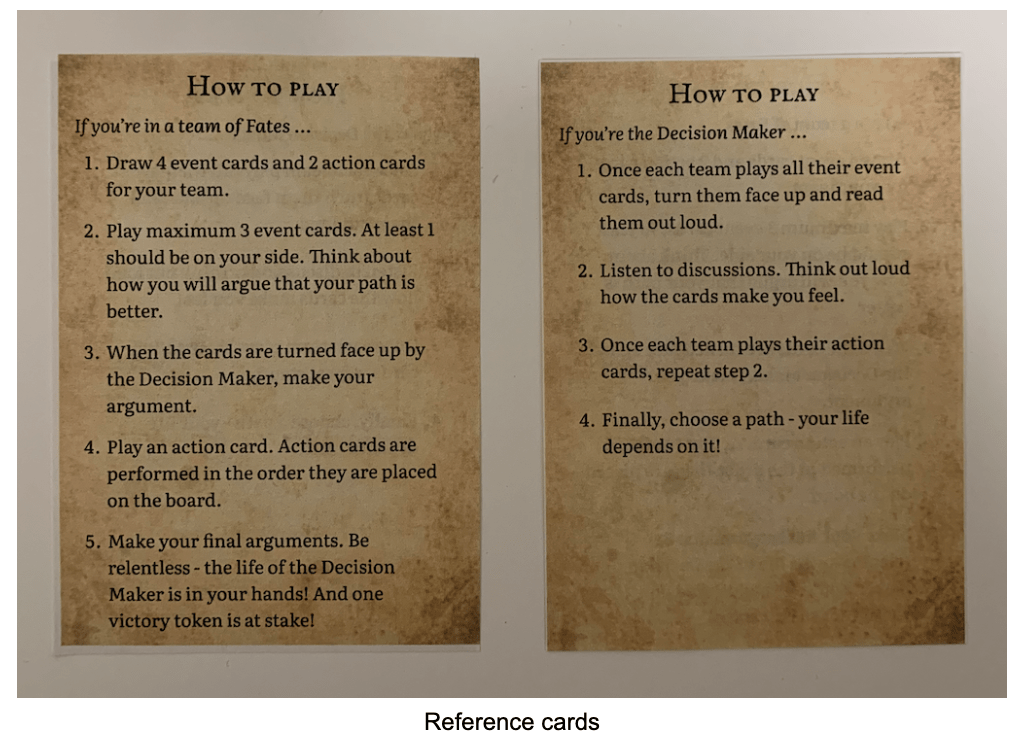
The cards were then color-coded, which made it easier to differentiate between event and action cards. We initially planned to have the whole card of the color (gold or brown) but changed it only for printer ink purposes.
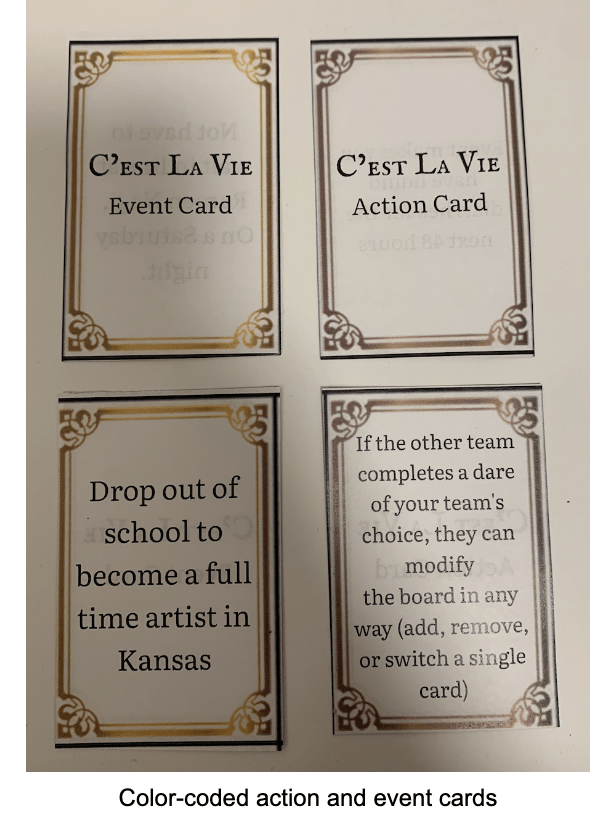
From the perspective of players on the two teams, it looked like there was great discussion among themselves and between the teams. The discussions got better after warming up for a short while. If some players are more quiet on a team, they would have less “autonomy” in playing the cards. Hence, the procedure of switching teams after each round also helped in this aspect.
From the perspective of the Decision Maker, they had a great time thinking about which side to pick. While teams were picking which cards to play, they felt slightly bored and suggested having a timer if it was getting too long. We actually recorded the amount of time that it took for the teams to play their cards (about 60 seconds for event cards, and 30 seconds for action cards). We thought it was fairly reasonable but in case we decide to introduce a timer in the future, this quantitative information would be very useful!
The team formation prompts that some playtesters said they enjoyed the most were the ones that were easiest to figure out (e.g. tallest people, closest birthday) compared to those that required players to remember something about their day or week (e.g. work up the earliest today, had the most drinks in the past week). Hence, we decided to make more of the former type of prompts but still keep a bunch of the latter type since we believed that the latter helped playtesters in getting to know each other more and a bunch of the playtesters liked that too.
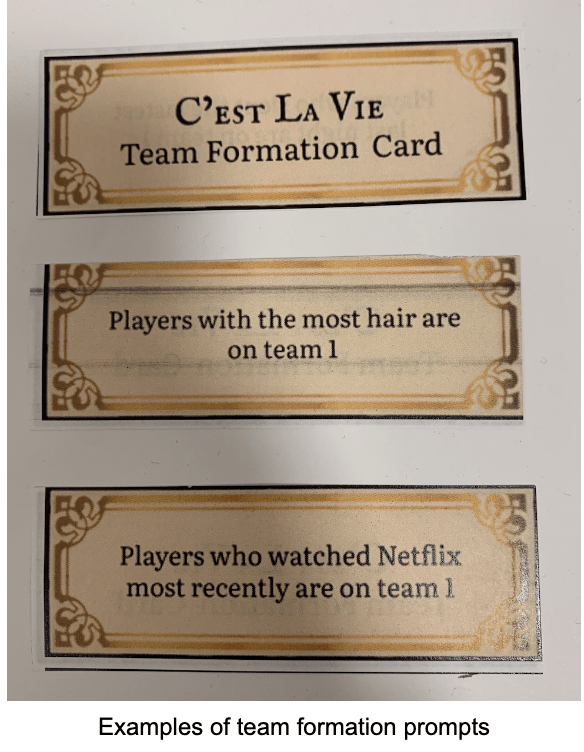
One interesting observation was that people spent the most time thinking and talking about the more “ridiculous” prompts. Hence, it was a good idea to have a mix of different types of prompts so people don’t have to really weigh 6 choices (cards played) to save time. Players also generally liked the more relatable prompts, which we decided to make more of.
Overall, there was a lot of positive feedback on our game. People really enjoyed the discussions they were having, and had lots of fun both being on the teams and being the Decision Maker. They learned a lot about other players and about themselves too! Playtesters also talked about liking the design and creativity of the game. Everything about the game including the language, the board, the reference cards, the action / event cards had a themed design, which really helped the players feel like they were in the “magic circle”.
One final note: the game worked really well when we playtested it with strangers, helping people break the ice by facilitating discussions. It also worked great and perhaps even better when we playtested it with groups of friends, which is probably because they knew one another better and played cards that they knew would relate most to the Decision Maker. They were also less scared of arguing and fighting with one another, which made the game really fun for everyone participating and watching!

Final Prototype
Print & Play Materials
Here’s a link to the Print & Play Version of this game!
Print & Play Instructions
(also found here in pdf form!)
What You Need:
- Color Printer
- Letter-Sized Paper (8.5 x 11 in)
- Tape or glue
- (optional) Poker Chips, Pennies, or Anything Else You Want to Use As Tokens
Directions:
- Print the game board (board.png) on two pieces of letter-sized paper single sided, landscape orientation and glue / tape them together
- Print out the event and action cards (event-action-cards.pdf) double-sided on letter-sized paper, landscape orientation and cut them out
- Print out the reference cards (reference-cards.pdf) double-sided on letter-sized paper, portrait orientation and cut them out
- Print out the team formation cards (team-formation-cards.pdf) double-sided on letter-sized paper, portrait orientation and cut them out
- (optional) If you’d like to play with paper tokens, print out the tokens (tokens.pdf) on letter-sized paper, landscape orientation and cut them out. You can play with your own tokens instead too!
Video of Final Playtest
Here’s a link to our in-class playtest!
Marketing Design Mockups
